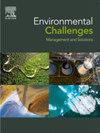循环生物经济中鳟鱼皮的增值:生态皮革生产和鞣制废水与鳟鱼副产品的厌氧共消化(摩洛哥)
Q2 Environmental Science
引用次数: 0
摘要
随着环境问题的日益严重,皮革行业的可持续替代品至关重要。本研究探索了鳟鱼皮作为生产生态皮革原料的潜力,并评估了其废水与同一鱼的副产品共同消化的生物降解性。3种底物S1、S2和S3的生物降解率分别为67.54%、41.95%和37.69%,实验产甲烷势分别为318 Nml/gVS、249 Nml/gVS和217 Nml/gVS。采用Logistic函数、修正Gompertz、传递函数和一阶动力学模型计算了三种基质的理论产甲烷势。与实验结果最接近的甲烷产率是Logistic函数预测,S1的产率为314.92 Nml/g VS,百分比误差为1.03%;S2的产率为249.38 Nml/g VS,百分比误差为0.16%;S3的产率为218.57 Nml/g VS,百分比误差为0.75%。修正Gompertz模型的预测结果与实验结果较为接近。这证实了估计鳟鱼副产品和制革废水共同消化的甲烷产量的最佳模型是修正的Gompertz和Logistic函数模型。这些发现为管理者和绿色经济利益相关者提供了制定合适的有机废物处理计划所需的信息。本文章由计算机程序翻译,如有差异,请以英文原文为准。

Valorization of trout skins for a circular bioeconomy: Ecological leather production and anaerobic co-digestion of tanning effluents with trout byproducts (Morocco)
With growing environmental concerns, sustainable alternatives in the leather industry are crucial. This study explores the potential of trout skins as a raw material to produce ecological leather and evaluates the biodegradability of the co-digestion of its effluents with the byproducts of the same fish. The biodegradability of the three substrates S1, S2 and S3 was 67.54 %, 41.95 % and 37.69 % respectively, while the experimental methanogenic potential was 318 Nml/g VS, 249 Nml/g VS and 217 Nml/gVS respectively. Four kinetic models were used to calculate the theoretical methanogenic potential of the three substrates: Logistic function, Modified Gompertz, Transference function and First order. The methane yield nearest to the experimental findings is that predicted by Logistic function, for S1 the yield was 314.92 Nml/g VS with a percentage error equal to 1.03 %, for S2 the yield was 249.38 Nml/g VS ( % error = 0.16 %), and for S3 the yield was 218.57 Nml/g VS ( % error = 0.75 %). Also, the results predicted by the Modified Gompertz model were close to experimental results. This confirms that the best models for estimating the methane yield from the co-digestion of trout byproducts and tannery effluent are the Modified Gompertz and Logistic function models. These findings give managers and green economy stakeholders the information they need to create suitable plans for handling organic waste.
求助全文
通过发布文献求助,成功后即可免费获取论文全文。
去求助
来源期刊

Environmental Challenges
Environmental Science-Environmental Engineering
CiteScore
8.00
自引率
0.00%
发文量
249
审稿时长
8 weeks
 求助内容:
求助内容: 应助结果提醒方式:
应助结果提醒方式:


